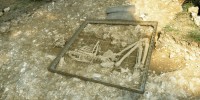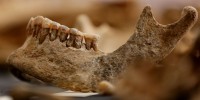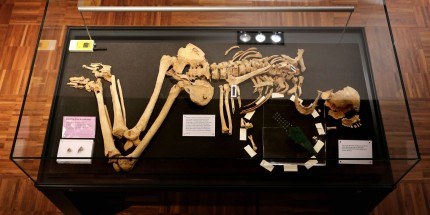 The year was 1989. Milli Vanilli had three number one singles and a metal detectorist discovered a bronze dagger blade and a few rivets on Racton Park Farm, near Westbourne, outside Chichester, West Sussex. A subsequent excavation of the find site unearthed the complete skeleton of an adult and three full bronze rivets that had once studded the dagger’s organic hilt, now long since decayed. He had been buried in a crouched position holding the handsome dagger in his right hand. Although there was no evidence of a burial mound, the value of the artifact and the careful positioning of the body suggested this was a high status individual.
The year was 1989. Milli Vanilli had three number one singles and a metal detectorist discovered a bronze dagger blade and a few rivets on Racton Park Farm, near Westbourne, outside Chichester, West Sussex. A subsequent excavation of the find site unearthed the complete skeleton of an adult and three full bronze rivets that had once studded the dagger’s organic hilt, now long since decayed. He had been buried in a crouched position holding the handsome dagger in his right hand. Although there was no evidence of a burial mound, the value of the artifact and the careful positioning of the body suggested this was a high status individual.
 The style of the dagger placed it in the transitional period between the Copper Age and the Early Bronze Age, about 2,200 – 2,100 B.C., making it one of the earliest bronze artifacts ever found in Britain and one of only seven studded rivet daggers known (three others were found in Britain, three in Ireland). Even though the discovery was clearly important, there was no money to research the remains in further detail, so the bones and artifacts were put in storage in Chichester. James Kenny, today the Chichester District Council’s archaeologist, was then part of the original excavation team. He published the find in an annual report that he and his team printed and stapled by hand. This was not a periodical of wide circulation, to put it mildly, so the word never got out and the find sank into obscurity.
The style of the dagger placed it in the transitional period between the Copper Age and the Early Bronze Age, about 2,200 – 2,100 B.C., making it one of the earliest bronze artifacts ever found in Britain and one of only seven studded rivet daggers known (three others were found in Britain, three in Ireland). Even though the discovery was clearly important, there was no money to research the remains in further detail, so the bones and artifacts were put in storage in Chichester. James Kenny, today the Chichester District Council’s archaeologist, was then part of the original excavation team. He published the find in an annual report that he and his team printed and stapled by hand. This was not a periodical of wide circulation, to put it mildly, so the word never got out and the find sank into obscurity.
Kenny never forgot about the dagger burial. Two years ago he and Stuart Needham, an expert in Bronze Age metallurgy, were examining a field in Sussex where a small hoard had been found when Kenny mentioned the riveted dagger he had excavated 23 years earlier. Kenny told his colleague it was still the most exciting find of his career and Needham was instantly intrigued. There are so few dagger burials on the record he thought he knew all of them, but Racton Man hadn’t made any of the journals so the discovery had fallen through the cracks in the scholarship.
 Kenny and Needham looked up the finds in the Novium Museum‘s archaeological stores and decided to seek out new funding to do a proper study. Their aim was to secure enough money to radiocarbon date the bones, do a stable isotope analysis of a tooth to discover where he grew up and a full osteological examination seeking evidence of illness or injury. The dagger would be analyzed to determine the metal content. They were able to get a £1,980 grant from the South Down National Park Authority’s Sustainable Communities Fund, a shocking pittance that was all they needed to get started. The rest of the funds were provided by the Chichester District Council.
Kenny and Needham looked up the finds in the Novium Museum‘s archaeological stores and decided to seek out new funding to do a proper study. Their aim was to secure enough money to radiocarbon date the bones, do a stable isotope analysis of a tooth to discover where he grew up and a full osteological examination seeking evidence of illness or injury. The dagger would be analyzed to determine the metal content. They were able to get a £1,980 grant from the South Down National Park Authority’s Sustainable Communities Fund, a shocking pittance that was all they needed to get started. The rest of the funds were provided by the Chichester District Council.
The first step was cleaning the bones. They had been put in storage directly after the excavation, so the osteological specialist wasn’t able to see much through the dirt. Properly cleaned, the bones were analyzed by experts from England, Wales and Scotland. They were able to confirm that Racton Man was, in fact, a man (the length of his bones suggested he was male, but it wasn’t certain until the study), and one who went down fighting.
Isotope analysis undertaken on one of the Racton Man’s teeth by experts from Durham University shows that he could have been brought up in southern Britain – possibly somewhere to the west of Sussex. Radiocarbon dating of the remains was undertaken by the Scottish Universities Environmental Research Centre in Glasgow. The result suggests that he died sometime in the period 2300BC – 2150BC.
Analysis of his bones by the London Institute of Archaeology suggests that he was 6ft tall and that he displays signs of spinal degeneration, which is thought to be age related. They also found that he suffered from a chronic sinus infection, as well as an abscess and tooth decay. Evidence has also been found of a peri-mortem cut – at or near the time of death – to the right upper arm bone, close to the elbow. There is no sign that this had healed. This is consistent with the arm being raised, elbow bent above the head, to protect it from a blow or strike from a weapon. These indications of actual fighting suggest that Racton Man’s dagger was not just for display. His social position may have depended on him demonstrating his prowess in combat.
Although less certain, there is also evidence of a similar blow having struck the lower part of the right shoulder, under the armpit. A sharp force blow to this area of the body would have been consistent with a double strike – one to the head, blocked by the raised right arm, and a second deep into the armpit, presumably to sever the major blood vessels in this area.
The dagger was not solely for ceremonial use. It had been repeatedly sharpened. The radiocarbon results of the burial make the dagger the earliest absolute dated bronze artifact ever discovered in Britain. This was the very dawn of alloy metallurgy so the dagger would have been an incredibly rare and expensive object, literally one of the first in the country.
You can see Racton Man and his dagger at the Novium Museum, on display in the same crouched position in which he was buried.
